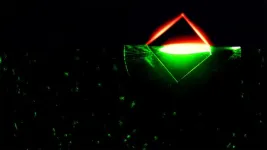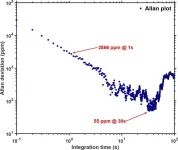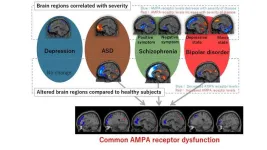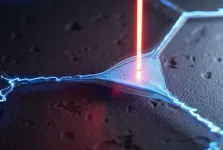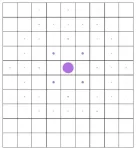(Press-News.org) Women with polycystic ovary syndrome (PCOS) and obesity are at a higher risk of giving birth to smaller babies in terms of birth weight, length, and head circumference, according to a recent study conducted at the Norwegian University of Science and Technology (NTNU).
One in eight women is affected by the hormone disorder PCOS. Common characteristics are elevated levels of male sex hormones, infrequent or irregular menstrual periods, and the formation of small cysts on the ovaries.
In the study, 390 children born to women with PCOS were compared to around 70,000 children from the Norwegian Mother, Father and Child Cohort Study (MoBa) (See the fact box.)
The researchers found that on average, the babies born to mothers with PCOS weighed less, were shorter, and had a smaller head circumference at birth. This was particularly the case when the mothers were obese, meaning they had a BMI over 30.
Co-occurrence of PCOS and obesity has the worst impact.
“In women of normal weight who have PCOS, we only find that their children have a lower birth weight compared to women who do not have PCOS. It is the group of children born to mothers with obesity that stands out the most. These babies have lower weight, shorter stature and a smaller head circumference. Obesity places an additional burden on mothers who have PCOS and their children,” said Professor Eszter Vanky at NTNU’s Department of Clinical and Molecular Medicine.
PCOS is a disease that follows women throughout their lives and can trigger various metabolic diseases and challenges such as diabetes, high blood pressure, and obesity. Women with PCOS are generally more likely to develop overweight and obesity.
“What is unusual is that women who are generally overweight and gain a lot of weight during pregnancy usually have an increased risk of giving birth to large babies. This also applies to women who develop gestational diabetes. On average, women with PCOS have higher BMIs, gain more weight during pregnancy, and 25 per cent of them develop gestational diabetes. However, the outcome is the opposite: these women give birth to babies who are smaller than average. We still don’t know why, but we see that the placenta is affected in these women,” said Vanky.
Placenta in overdrive
The newly qualified doctors Maren Talmo and Ingvild Fløysand have carried out the study as their master’s thesis, with Eszter Vanky and Melanie Rae Simpson as their supervisors. Talmo explains that even though the placenta in these women is smaller in size, it seems to deliver more nutrients relative to the baby’s body weight compared to a normal placenta. Vanky describes it as a placenta in overdrive.
“The placenta delivers nutrients to the baby through the umbilical cord. In women with PCOS, we see that the placenta is generally smaller in size. At the same time, it must provide everything the baby needs, so it has to work very hard to meet these demands. Sometimes, however, the placenta can’t keep up, which can lead to placental insufficiency and, in rare cases, foetal death.”
The researchers do not know why this is the case.
“There are many hypotheses, but I don’t think anyone has a definitive answer yet. Previously, we thought the cause was linked to the high levels of male sex hormones, but we have not been able to fully connect the two. We also know that women with PCOS have a slightly different immune profile during pregnancy.”
Follow-up during pregnancy
The researchers believe this is important knowledge both for the women affected and for healthcare professionals.
“A newborn baby is not a blank slate. Much of our long-term health is established in the womb. Genes play a role, but also what we are exposed to during the foetal stage and early in life,” said Vanky.
The NTNU researchers now want to learn more about what happens to the children’s health.
“What are the consequences of the mother’s PCOS diagnosis for the child? Is there anything that can be done before or during pregnancy so that expectant mothers with PCOS do not gain too much weight? Can follow up and good glucose regulation be provided so that the child gets the best outcome possible? All this depends on knowing more about the mother’s situation,” said Vanky.
Affected throughout life
The NTNU researchers have also followed up on some of the children when they reached the age of 7 years.
“We saw that the children born to mothers with PCOS generally had more central obesity, meaning they were larger around the waist,” said Vanky.
Other studies have shown that children born to mothers with PCOS are at higher risk of developing overweight and obesity at a young age. Research has also shown that low birth weight is linked to the development of type 2 diabetes and cardiovascular disease later in life.
“We see differences in children as early as 7 or 8 years old, where children born to mothers with PCOS have a larger waist circumference and higher BMI. They bear small signs that their mother has PCOS. It may therefore be an advantage to know about this so we can provide guidance on lifestyle and diet,” said Vanky
Source: Talmo MSA, Fløysand IS, Nilsen GØ, et al. Growth Restriction in the Offspring of Mothers With Polycystic Ovary Syndrome. JAMA Netw Open. 2024;7(8):e2430543. doi:10.1001/jamanetworkopen.2024.30543
END
A mother’s health problems pose a risk to her children
Pregnant moms with PCOS who are obese benefit from extra help during pregnancy to reduce risks to their children.
2024-11-05
ELSE PRESS RELEASES FROM THIS DATE:
Ensuring a bright future for diamond electronics and sensors
2024-11-05
Researchers are developing new ideas about the best ways to make lab-grown diamonds while minimizing other forms of carbon, such as soot. These diamonds aren’t destined for rings and necklaces, though. These are the kinds that are needed for the computers, optics and sensors of the future.
One new study, conducted by researchers at the U.S. Department of Energy’s (DOE) Princeton Plasma Physics Laboratory (PPPL) and Princeton University, investigated ways to reliably grow diamond at lower temperatures than those currently used. Diamond has properties ...
The American Pediatric Society selects Dr. Maria Trent as the Recipient of the 2025 David G. Nichols Health Equity Award
2024-11-05
The American Pediatric Society (APS) is pleased to announce Maria E. Trent, MD, MPH, as the 2025 David G. Nichols Health Equity Award recipient.
The David G. Nichols Health Equity Award, administered by the APS and endowed by the American Board of Pediatrics (ABP) Foundation, was created to recognize demonstrated excellence in advancing child and adolescent health, well-being, and equity through quality improvement, advocacy, practice, or research. This award recognizes Dr. Trent’s outstanding contributions to advancing child and adolescent health, well-being, and equity and the far-reaching impact of her work. The award will be presented to Dr. Trent ...
The first 3D view of the formation and evolution of globular clusters
2024-11-05
A study published today in Astronomy & Astrophysics marks a significant milestone in our understanding of the formation and dynamical evolution of multiple stellar populations in globular clusters (spherical and very compact stellar agglomerates typically populated by 1–2 million stars). This pioneering study, conducted by a group of researchers from the National Institute for Astrophysics (INAF), the University of Bologna, and Indiana University, is the first to perform a 3D kinematic analysis of multiple stellar populations for a representative sample of 16 globular clusters in our Galaxy. It provides ...
Towards a hydrogen-powered future: highly sensitive hydrogen detection system
2024-11-05
Hydrogen gas is a promising energy source with several advantages - it is lightweight, storable, energy-dense, and environmentally friendly compared to fossil fuels, producing no pollutants or greenhouse gas emissions. As such, it has extensive applications across different fields, including transportation, architecture, power generation, and industries. However, hydrogen is highly flammable, and therefore its safe and widespread use requires reliable methods for detecting leaks and ensuring its purity. The need for reliable detection methods has necessitated the development of trace-gas sensing techniques. While several methods have been developed for hydrogen sensing, ...
Scanning synaptic receptors: A game-changer for understanding psychiatric disorders
2024-11-05
Even though psychiatric disorders such as schizophrenia, bipolar disorder, and autism spectrum disorder (ASD) are quite common, their diagnosis and treatment are challenging. While doctors today have a good idea of the clinical symptoms caused by these disorders, our overall understanding of their biological characteristics and underlying physiological causes remain obscure.
Experts agree that problems with synapses—the connections that allow communication between neurons—might be a defining feature ...
High-quality nanomechanical resonators with built-in piezoelectricity
2024-11-05
Researchers at Chalmers University of Technology in Sweden and at the University of Magdeburg in Germany have developed a novel type of nanomechanical resonator that combines two important features: high mechanical quality and piezoelectricity. This development could open doors to new possibilities in quantum sensing technologies.
Mechanical resonators have been used for centuries for a multitude of applications. A key aspect of these devices is their ability to vibrate at specific frequencies. A well-known example is the tuning fork. When struck, the tuning fork oscillates at its resonance frequency, producing a sound wave within our hearing range. ...
ERC Synergy Grants for 57 teams tackling major scientific challenges
2024-11-05
Iliana Ivanova, Commissioner for Innovation, Research, Culture, Education and Youth, said: “Innovation thrives on collaboration, especially when tackling the pressing scientific challenges of our time. The ERC Synergy Grants work with Horizon Europe funding to connect brilliant minds across borders and disciplines, enabling them to push the frontiers of knowledge together. I am particularly delighted to see researchers from countries with historically fewer ERC grants among the awardees, reflecting our mission to ...
Nordic research team receives €13 million to explore medieval book culture
2024-11-05
The CODICUM project brings together experts in history, literature, and bio-codicology from four Nordic universities to explore medieval knowledge networks. This groundbreaking study combines traditional humanities approaches with cutting-edge biomolecular analysis of fragments from medieval books, written on animal skin.
How book culture shaped medieval Europe
The project will investigate approximately 50,000 medieval Latin book fragments preserved in Nordic collections—one of Europe’s largest archives of medieval book culture.
"These fragments represent an extraordinary treasure trove that can transform our understanding ...
The origin of writing in Mesopotamia is tied to designs engraved on ancient cylinder seals
2024-11-05
The origins of writing in Mesopotamia lie in the images imprinted by ancient cylinder seals on clay tablets and other artifacts. A research group from the University of Bologna has identified a series of correlations between the designs engraved on these cylinders, dating back around six thousand years, and some of the signs in the proto-cuneiform script that emerged in the city of Uruk, located in what is now southern Iraq, around 3000 BCE.
The study—published in Antiquity—opens new perspectives on ...
Explaining science through dance
2024-11-05
Science can be difficult to explain to the public. In fact, any subfield of science can be difficult to explain to another scientist who studies in a different area. Explaining a theoretical science concept to high school students requires a new way of thinking altogether.
This is precisely what researchers at the University of California San Diego did when they orchestrated a dance with high school students at Orange Glen High School in Escondido as a way to explain topological insulators.
The experiment, led by former graduate student Matthew Du and UC San Diego Associate Professor of Chemistry and Biochemistry Joel Yuen-Zhou, was published in Science Advances.
“I ...
LAST 30 PRESS RELEASES:
KIST develops eco-friendly palladium recovery technology to safeguard resource security
Statins significantly reduce mortality risk for adults with diabetes, regardless of cardiovascular risk
Brain immune cells may drive more damage in females than males with Alzheimer’s
Evidence-based recommendations empower clinicians to manage epilepsy in pregnancy
Fungus turns bark beetles’ defenses against them
There are new antivirals being tested for herpesviruses. Scientists now know how they work
CDI scientist, colleagues author review of global burden of fungus Candida auris
How does stroke influence speech comprehension?
B cells transiently unlock their plasticity, risking lymphoma development
Advanced AI dodel predicts spoken language outcomes in deaf children after cochlear implants
Multimodal imaging-based cerebral blood flow prediction model development in simulated microgravity
Accelerated streaming subgraph matching framework is faster, more robust, and scalable
Gestational diabetes rose every year in the US since 2016
OHSU researchers find breast cancer drug boosts leukemia treatment
Fear and medical misinformation regarding risk of progression or recurrence among patients with breast cancer
Glucagonlike peptide-1 receptor agonists and asthma risk in adolescents with obesity
Reviving dormant immunity: Millimeter waves reprogram the immunosuppressive microenvironment to potentiate immunotherapy without obvious side effects
Safety decision-making for autonomous vehicles integrating passenger physiological states by fNIRS
Fires could emit more air pollution than previously estimated
A new way to map how cells choose their fate
Numbers in our sights affect how we perceive space
SIMJ announces global collaborative book project in commemoration of its 75th anniversary
Air pollution exposure and birth weight
Obstructive sleep apnea risk and mental health conditions among older adults
How talking slows eye movements behind the wheel
The Ceramic Society of Japan’s Oxoate Ceramics Research Association launches new international book project
Heart-brain connection: international study reveals the role of the vagus nerve in keeping the heart young
Researchers identify Rb1 as a predictive biomarker for a new therapeutic strategy in some breast cancers
Survey reveals ethical gaps slowing AI adoption in pediatric surgery
Stimulant ADHD medications work differently than thought
[Press-News.org] A mother’s health problems pose a risk to her childrenPregnant moms with PCOS who are obese benefit from extra help during pregnancy to reduce risks to their children.



